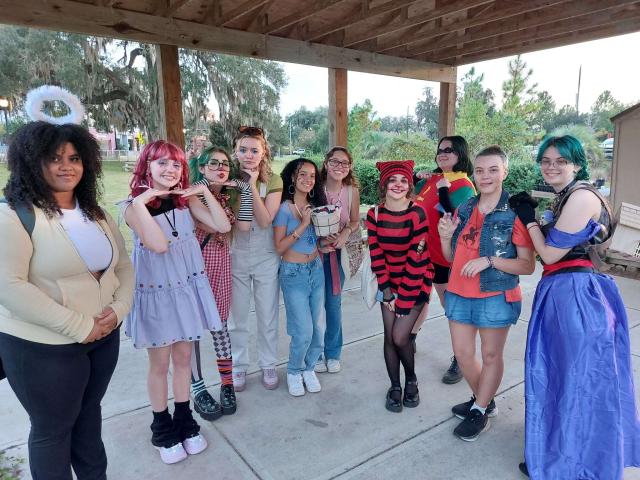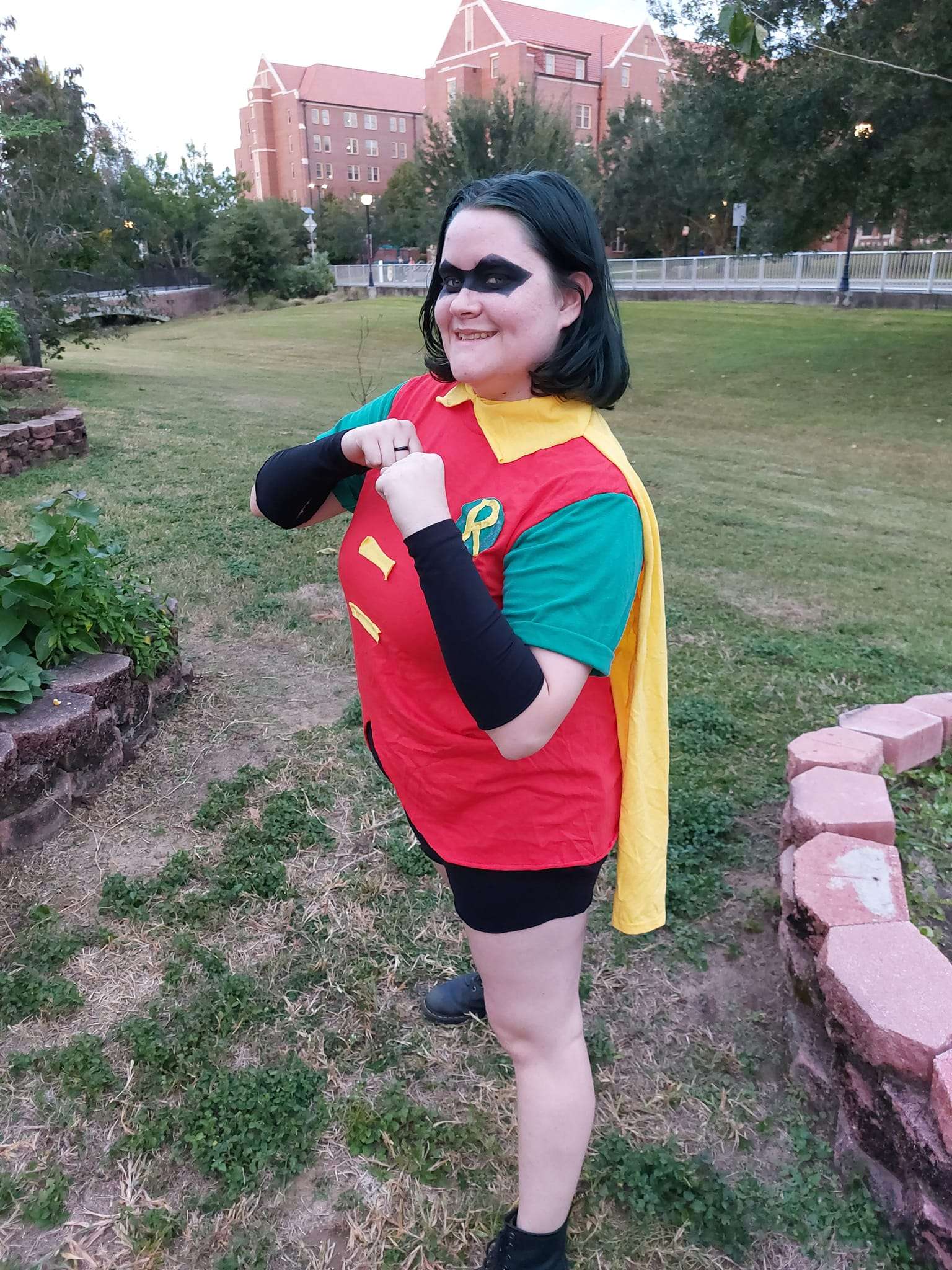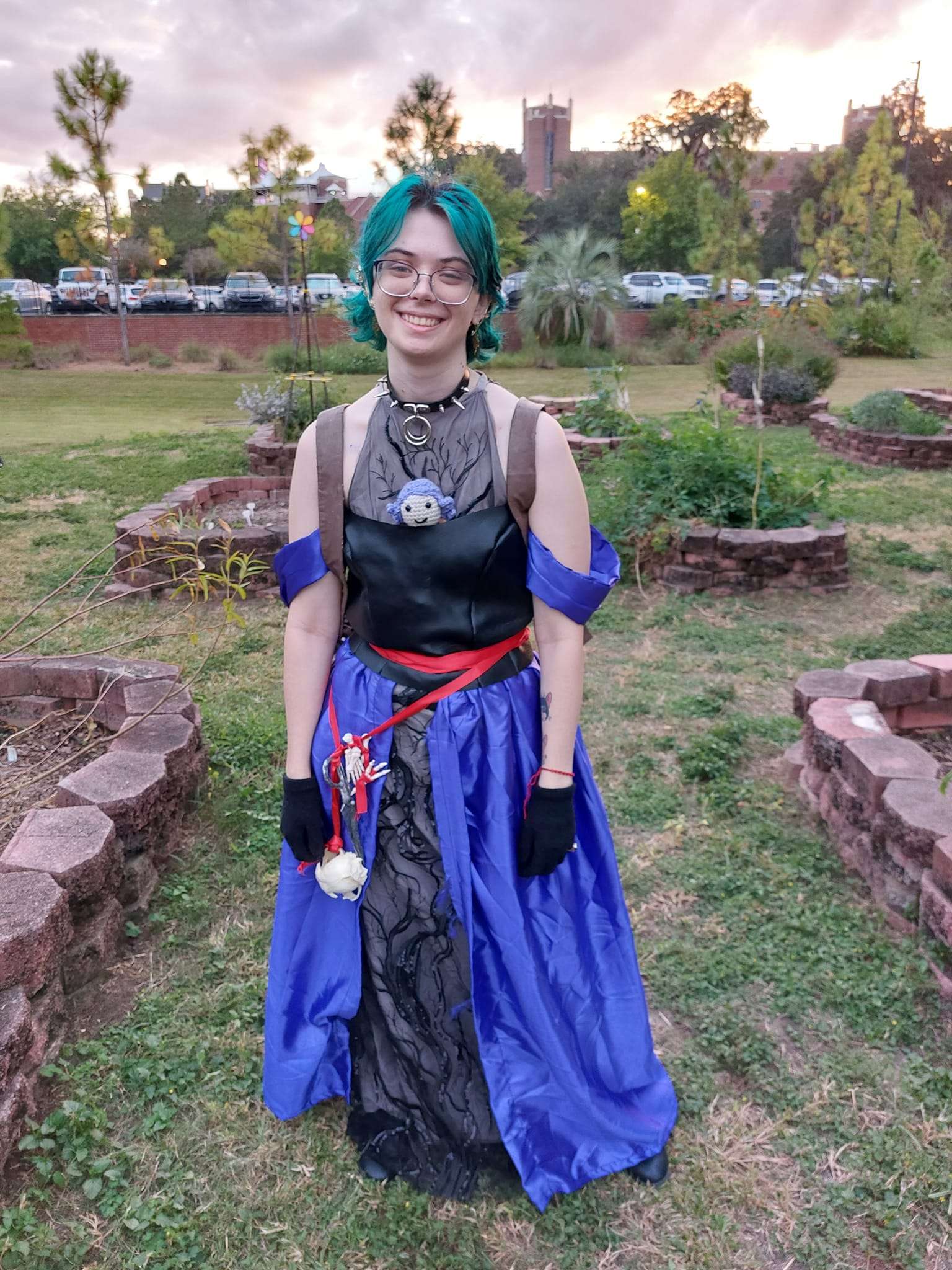What's The Stitch? - Behind the Scenes With Our Sustainable Costume Contest Winners

On October 24th, 2023, Sustainable Campus held our Fall Festival in the Seminole Organic Garden. Celebrating Halloween, Fall, and the ten-year anniversary of the Garden, it was a big celebration. The festival featured outdoor games, upcycled tote bag creation and decorations, birthday wishes for the Garden, and, the main event, a sustainable costumes contest. Students were encouraged to show up to the event in costume and enter their looks for judging if the costumes were made sustainably. A “sustainable” costume could mean a lot of things based on the provided criteria. Eligible costumes could be thrifted, upcycled, hand-sewn, or pulled from clothes contestants already owned. Upon entering, students were given a chance to explain how they made their costumes and what made the costumes sustainable. Receiving crowns made of decorated cardboard and plastic bags, three groups/individuals were crowned winners based on their costume’s sustainability, presentation, originality, and craftsmanship.
In first place was crowned Robyn Bell (she/they), a third-year who came dressed as Robin from DC Comics. Made out of three upcycled and thrifted t-shirts to recreate the iconic red, green, and yellow top, and an upcycled pair of leggings to create the arm braces and shorts, the costume was made with sustainability in mind. Both their favorite and most challenging part of making the costume was figuring out how to make the cape out of an old t-shirt, and getting to mess with shapes and challenge herself. Robyn describes sustainability as “any action I take to try reducing harm done to the environment,” and, when expanding beyond the reaches of Halloween, explains that she, “bring[s] this same sort of mindset into my everyday closet, not just my cosplay one. I strive to find things second-hand and try to only purchase things I know that I’ll be able to wear again and again and again. Plus, when creating a new costume I always seem to find new ways to make my pieces versatile enough that I can wear them in my day-to-day life!” Their interest in sustainable costuming stems from an interest in general costuming. A cosplayer and costume designer by hobby, it was a natural progression to learn to sew to make their pieces, rather than ordering from fast fashion retailers and receiving costumes that often didn’t fit right, fell apart in a few years, and would be used once. Though the process of hand-making certainly takes more time and effort, Robyn explains she’s happier with the quality of her pieces overall when she makes them herself, and that they last longer and are more likely to be usable in their everyday wear when they use sustainable methods.
top, and an upcycled pair of leggings to create the arm braces and shorts, the costume was made with sustainability in mind. Both their favorite and most challenging part of making the costume was figuring out how to make the cape out of an old t-shirt, and getting to mess with shapes and challenge herself. Robyn describes sustainability as “any action I take to try reducing harm done to the environment,” and, when expanding beyond the reaches of Halloween, explains that she, “bring[s] this same sort of mindset into my everyday closet, not just my cosplay one. I strive to find things second-hand and try to only purchase things I know that I’ll be able to wear again and again and again. Plus, when creating a new costume I always seem to find new ways to make my pieces versatile enough that I can wear them in my day-to-day life!” Their interest in sustainable costuming stems from an interest in general costuming. A cosplayer and costume designer by hobby, it was a natural progression to learn to sew to make their pieces, rather than ordering from fast fashion retailers and receiving costumes that often didn’t fit right, fell apart in a few years, and would be used once. Though the process of hand-making certainly takes more time and effort, Robyn explains she’s happier with the quality of her pieces overall when she makes them herself, and that they last longer and are more likely to be usable in their everyday wear when they use sustainable methods.
We also followed up with our second-place winner, Sofie Davidson (she/they). Dressed as Laudna from Critical Role, her costume was borrowed from a friend (ironically enough, from Robyn, our first-place winner). The costume is entirely hand-sewn and most of the props and accessories are in some  way hand-made or upcycled. Since they didn’t make the costume themselves, they described their favorite part of the experience as getting to style it and finding ways to add the accessories in a unique and fun way, especially as many of the accessories came as a bit of a surprise. Sofie had not had much of a previous interest in sustainable costuming before this event and explains that this experience helped add to the motivation that not only can hand-making your costumes be more fun, but that it can be good for the environment too. She added that she plans to have sustainability at the heart of any future projects. To them, sustainability is about finding ways to minimize damage to the environment and doing so in a socially and ethically conscious way. This can extend to hand-making costumes, ethically sourced Halloween candies, or any number of aspects of everyday life. When carrying the sustainability principles put into practice for this event into the scope of the everyday, she adds, “There’s never anything wrong with asking a friend for help! Sharing is caring, and it can be good for the environment too!”
way hand-made or upcycled. Since they didn’t make the costume themselves, they described their favorite part of the experience as getting to style it and finding ways to add the accessories in a unique and fun way, especially as many of the accessories came as a bit of a surprise. Sofie had not had much of a previous interest in sustainable costuming before this event and explains that this experience helped add to the motivation that not only can hand-making your costumes be more fun, but that it can be good for the environment too. She added that she plans to have sustainability at the heart of any future projects. To them, sustainability is about finding ways to minimize damage to the environment and doing so in a socially and ethically conscious way. This can extend to hand-making costumes, ethically sourced Halloween candies, or any number of aspects of everyday life. When carrying the sustainability principles put into practice for this event into the scope of the everyday, she adds, “There’s never anything wrong with asking a friend for help! Sharing is caring, and it can be good for the environment too!”
Every student who took the time and effort to participate helped make the Fall Festival the success it was. Both celebrating Halloween and educating about its environmental impact, the Fall Festival highlighted the concept that environmental education can be about both challenges and triumphs. The tips and principles discussed here can be used throughout the year and across every piece of life. Sustainability in fashion should be part of a year-round thought process, whether it’s for costumes, holidays, or the clothing we wear every day. Every little decision can help make a difference, and those choices don’t have to end with the Halloween season.

